- Submissions

Full Text
Advancements in Bioequivalence & Bioavailability
Higher Bioavailability and Contamination by Copper in the Edible Mussels, Snails and Horseshoe Crabs at Kampung Pasir Puteh: Evidence of an Industrial Effluent Receiving Site at Pasir Gudang Area
Chee Kong Yap1*, Weiyun Chew1, Wan Hee Cheng2, Hideo Okamura3, Hiroya Harino4, Shih Hao Tony Peng5 and Chee Seng Leow6
1Department of Biology, Faculty of Science, Malaysia
2Inti International University, Malaysia
3Research Center for Inland Seas, Japan
4Department of Human Sciences, Japan
5All Cosmos Biotech Holding Corporation, Malaysia
6Humanology Sdn, Malaysia
*Corresponding author: Chee Kong Yap, Department of Biology, Faculty of Science, 43400 UPM, Serdang, Selangor, Malaysia
Submission: May 22, 2019;Published: June 14, 2019
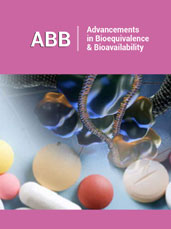
ISSN 2640-9275 Volume2 Issue5
Abstract
This paper determined the heavy metal concentrations (Cd, Cu, Fe, Pb, Ni and Zn) in the different soft tissues of mussel perna viridis, mudflat snail telescopium telescopium, and horseshoe crabs (Carcinoscorpius rotundicauda and Tachypleus gigas), and their habitat surface sediments from an industrial effluent receiving site Kg [1-6]. Pasir Putter (KPPuteh) (a site close to Pasir Gudang industrial area) and relatively unpolluted sites. The sediment data clearly showed that KPPuteh had higher nonresistant geochemical fraction of heavy metals, indicating anthropogenic sources and metal contamination at KPPuteh. However, based on the metal concentrations in all the different soft tissues of the above four biomonitors, Cu was significantly higher than the other comparative site, indicating distinct higher Cu bioavailabilities to the four biomonitors. Thus, it is evidenced and confirmed that KPPuteh was contaminated by heavy metals, having high Cu bioavailability to the four biomonitors [6-11].
Keywords: Biomonitors; Cu bioavailability; Sediments; Malaysia
Introduction
Kampung Pasir Puteh (KPPuteh) at pasir gudang, located in the eastern part of the straits of johore, peninsular malaysia, caught a lot of public and ministerial governance attention in March 2019 with kim kim river pollution due to chemical waste contamination [2,12,13]. Kim Kim River estuary is just 3.5km from the sampling sites of the present study at KPPuteh. Based on several published papers [14-20]. KPPuteh was reported to have higher metal concentrations based on sediment and green-lipped mussel perna viridis. This has prompted more monitoring and biomonitoring studies on this ‘Hotspot’ site in Malaysia since a question on ‘Would other intertidal biota also show higher metal concentrations at KPPuteh?’ could arise. One the simple way to answer the question is to compare the metal concentrations in the other biota species between this site and other geographical site in Malaysia.
In the present study, mussels, snails and two species of horseshoe crabs were employed as biomonitors to determine metal bioavailabilities while sediment samples were used to determine the metal contamination. The advantages of the use of sediments in the monitoring studies include an agent of transport and storage of metals, source identification of heavy metals spatially and temporally and it can be used to locate the main sinks for heavy metals [3]. The sediment samples were also geochemically fractionated and the percentage of nonresistant fraction which is related to anthropogenic sources of metals was also estimated [1]. The intertidal mussels, snails and horseshoe crabs were chosen as biomonitors of heavy metal bioavailability since they are relatively sedentary animals (limited movements especially for mussels and snails), long-lived, easily identified and sampled, tolerant to natural environmental fluctuations and pollution, and ecologically important [5,10].
In particular, mussels and snails are reasonably abundant and available throughout the year although the horseshoe crabs seem not to fulfill these two criteria [4]. Still, there is a lot of literature documenting the use of horseshoe crabs in the biomonitoring heavy metal studies [4,6,21,22]. In Malaysia, the use of P viridis [13,15,16,19,20,21], mudflat snail telescopium telescopium [13,21] and horseshoe crabs tachypleus gigas [22] for the biomonitoring heavy metal pollution are reported in the literature.
In this study, the concentrations of heavy metals in the different soft tissues of P viridis, T telescopium, horseshoe crabs (Carcinoscorpius rotundicauda and T gigas) and the geochemical fractions of the sediments were determined and the results for the four sites were compared. The objective of this study was to compare the heavy metal concentrations in the green-lipped mussel, mudflat telescope snail, two species of horseshoe crabs and sediments collected between the polluted site at KPPuteh and relatively unpolluted sites (Kukup, Sg. Balang Laut (SBLaut), Laut Kurong Tengar (LKTengar) and Bukit Tok Poh (BTPoh).
Materials and Methods
The sampling map for the four biomonitors and surface sediments (0-10cm) in the intertidal area of Peninsular Malaysia is given in Figure 1. The descriptions for the sites are given in Table 1 while the sizes (shell lengths for mussels, shell height for snails and body length for horseshoe crabs) and numbers of individuals analyzed are given in Table 2. For the mussels, the soft tissues were dissected and pooled into mantle, gill, gonad, foot, crystalline style, muscle and remainder besides byssus. For the snails, the soft tissues were dissected and pooled into cephalic tentacles, digestive caecum, gills, mantle, foot, muscle and remainder while both species of the horseshoe crabs were prosomatic carapace, opisthosomatic carapace, telson, eggs, gills, operculum, abdomen muscle, digestive organs, remains (shells) and remains (soft tissues).
Figure 1:Map showing sampling sites of telescopium telescopium, Perna viridis, Tachypleus gigas and Carcinoscorpius rotundicauda, and the surface sediments in the west intertidal area of Peninsular Malaysia. Note: Numbers of sampling sites follow those in Table 1.
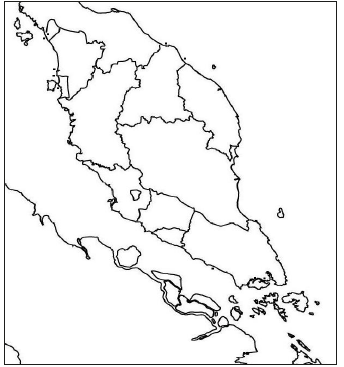
Table 1:Sampling information for telescopium telescopium, Perna viridis, Tachypleus gigas and Carcinoscorpius rotundicauda, and the surface sediments in the west intertidal area of Peninsular Malaysia.

Table 2:Sizes for the mussels, snails and horseshoe crabs analyzed in the present study. N= number of individuals analyzed.
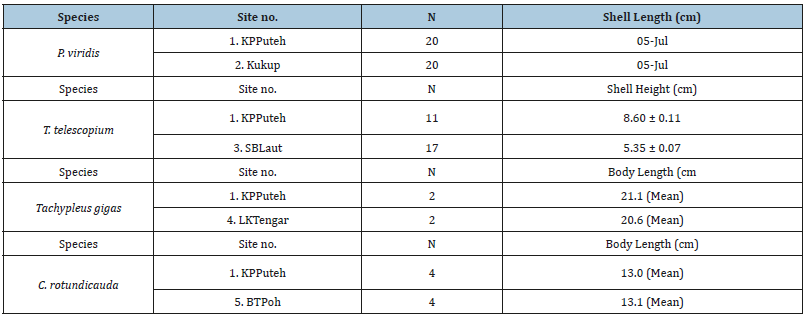
Note: Numbers of sampling sites follow those in Figure 1.
The different pooled tissues were dried at 80 °C in an oven for 72h until constant dry weights (dw) [12]. For the biological samples, three replicates of each different pooled tissues were then digested in concentrated nitric acid (AnalaR grade; BDH: 69%) [17]. For the sediments, the dried sediment samples were crushed by using a mortar and pestle and sieved through a 63μm aperture stainless steel sieve and were shaken vigorously to produce homogeneity [18]. For the analyses of total metal concentrations in the sediment samples, three replicates were analyzed by using the direct aqua-regia (AR) method [19]. In this AR method, about 1g of each dried sample was digested in a combination of concentrated HNO3 (AnalaR grade; BDH 69%) and HClO4 (AnalaR grade; BDH 60%) in the ratio of 4:1.
The biological samples and sediment samples were put into a hot-block digester first at low temperature (40 °C) for 1hr and then were fully digested at 140 °C for at least 3hrs [17,18]. For the analytical procedures for four geochemical fractions of the surface sediments, sequential extraction technique described by Badri and Aston and slightly modified by Yap CK [18] was used. These four fractions employed were easily, freely, leacheable, or exchangeable, (EFLE), acid-reducible, oxidisable-organic and resistant. The summation of first three fractions form the nonresistant fraction which is mostly related to various anthropogenic sources and thus provides an estimate of human-induced fraction [1,18].
The concentrations of Cd, Cu, Fe, Pb, Ni and Zn of the digested filtrates of both the biological and sediments were determined using an air-acetylene flame atomic absorption spectrophotometer (FAAS) Perkin-Elmer Model Analyst 800. The data are presented in μg/g dw basis. Multiple level calibration standards were analyzed to generate calibration curves against which the sample concentrations can be calculated. Standard solutions of all metals were prepared from 1000mg/L stock solutions of each metal (MERCK Titrisol). To avoid possible contamination, all the glassware and equipment used were acid-washed. Procedural blanks and quality control samples made from standard solutions with each metal were analyzed once every five samples in order to check for sample accuracy [19].
In addition, the quality of the analytical procedures used for sediment analysis were checked by a Certified Reference Material (CRM) for Soil (Soil-5, IAEA, Vienna, Austria) while for the biological samples were verified by using CRM for Dogfish Liver (DOLT-3, National Research Council Canada). The recoveries for both CRMs were being satisfactory between 80-120%.
Result and Discussion
Based on the comparison of metal concentrations in the different soft tissues of P viridis (Table 3), KPPuteh population was significantly (P<0.05) higher than in the Kukup population, for Cu and Zn based on all the eight tissues. For Pb, in all tissues except for gills, Ni in all tissues except for gills and muscles while Cd is only significantly (P<0.05) higher in mantle, remainder, CS and muscle. Therefore, higher bio availabilities of metals to P viridis follow the order: Cu=Zn> Pb> Ni> Cd. Based on the comparison of metal concentrations in the different soft tissues of T telescopium (Table 4), KPPuteh population was higher (although not necessarily significant) than in the Kukup population, for Cd and Cu based on all the seven tissues.
Table 3:Heavy metal concentrations (mean μg/g dry weight) in the different parts of Perna viridis collected from Kg. Pasir Puteh (KPPuteh) and Kukup.

Note: Values in bold indicate significant (P< 0.05) higher metal concentrations found at Kg. Pasir Puteh population.
Table 4:Concentrations (μg/g dry weight) of heavy metals in the different parts of telescopium telescopium collected from Kg. Pasir Puteh (KPPuteh) and Sg. Balang Lau (SBLaut).
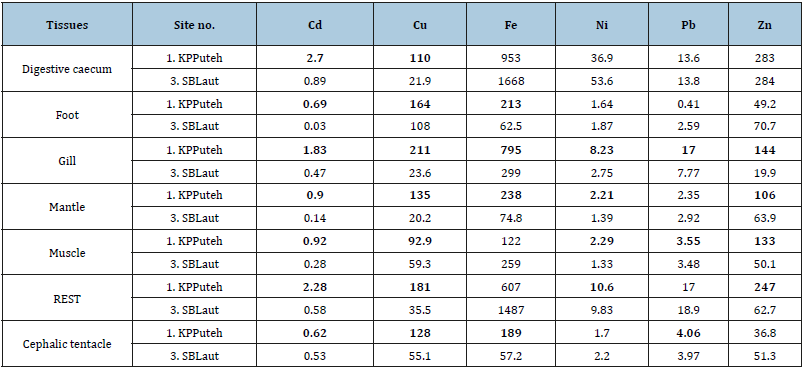
Note: Values in bold indicate significant (P< 0.05) higher metal concentrations found at Kg. Pasir Puteh population. REST=remainder of the soft tissues.
For Fe, Ni and Zn, four out of seven tissues were higher in KPPuteh when compared to SBLaut populations while Pb was only significantly (P<0.05) higher in three tissues namely gill, muscle and CT. Therefore, higher bio availabilities of metals to T telescopium follows the order: Cd=Cu> Fe= Ni= Zn > Pb. Based on the comparison of metal concentrations in the different soft tissues of T gigas (Table 5), KPPuteh population was higher (although not necessarily significant) than in the LKTengar population, for Cu based on all the ten tissues. For Zn and Cd, five out of ten tissues were higher in KPPuteh when compared to KKTengar population while Ni was only significantly (P<0.05) higher in three tissues namely egg, abdomen muscle and shell remains.
Table 5:Heavy metal concentrations (mean μg/g dry weight) in the different parts of Tachypleus gigas collected from Kg. Pasir Puteh (KPPuteh) and Laut Kurung Tengar (LKTengar).
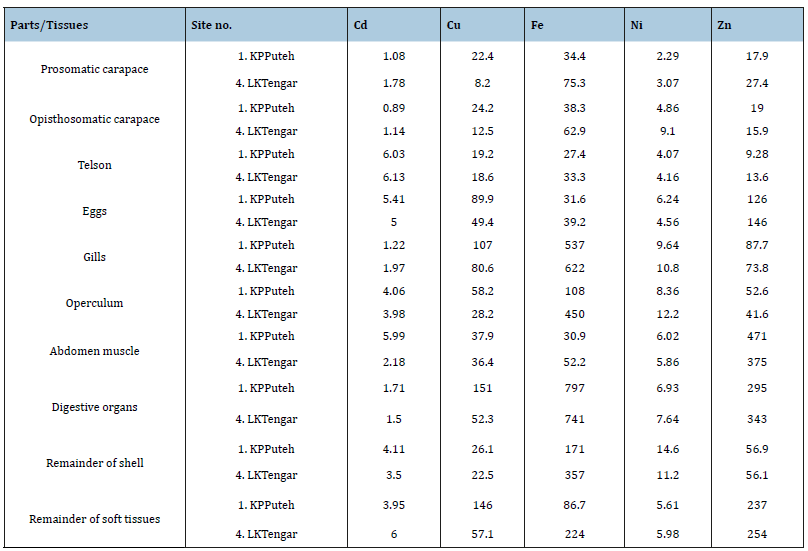
Note: Pb was not analyzed due to instrumental failure during analysis. Values in bold indicate significant (P< 0.05) higher metal concentrations found at Kg. Pasir Puteh population.
Therefore, higher bio availabilities of metals to T gigas follow the order: Cu> Zn= Cd > Ni. Based on the comparison of metal concentrations in the different soft tissues of C rotundicauda (Table 6), KPPuteh population was higher (although not necessarily significant) than in the BTPoh population, for Cu based on eight out of ten tissues. For Ni, six out of ten tissues were higher in KPPuteh when compared to BTPoh populations while Fe was higher in five tissues while Cd and Zn were higher in only four tissues out of ten tissues. Therefore, higher bio availabilities of metals to T gigas follow the order: Cu> Ni > Fe > Cd= Zn. In overall, based on the metal concentrations in the different tissues of mussels, snails and two species of horseshoe crabs (Table 3-6), significantly higher bioavailability of Cu to the four biomonitors are found. According to Rainbow [11], the use of a suite of biomonitors for the biomonitoring of metal availabilities in the coastal area is highly recommended.
Table 6:Heavy metal concentrations (mean μg/g dry weight) in the different parts of Carcinoscorpius rotundicauda collected from Kg. Pasir Puteh (KPPuteh) and Bukit Tok Poh (BTPoh).
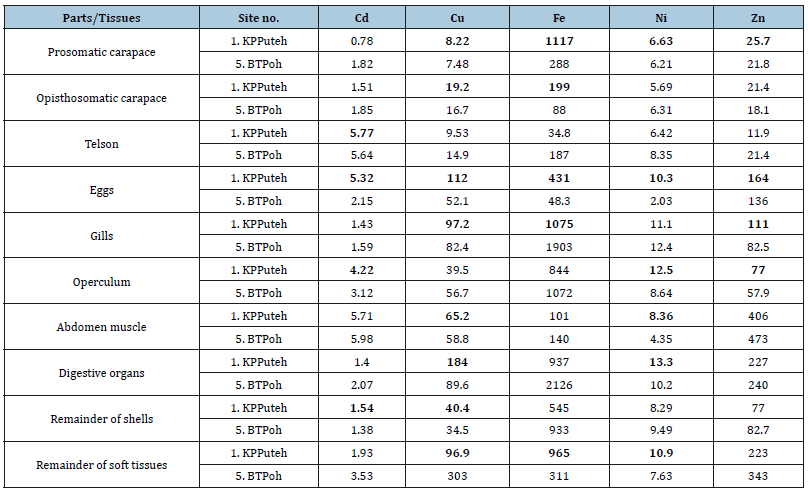
Note: Pb was not analyzed due to instrumental failure during analysis. Values in bold indicate significant (P< 0.05) higher metal concentrations found at Kg. Pasir Puteh population.
The total metal concentrations and percentages of nonresistant geochemical fractions in the surface sediments of the sampling sites are presented in Table 7. It is shown that the highest metal concentrations of Cu, Fe, Ni, Pb and Zn were found in KPPuteh, when compared sampling sites at Kukup, SBLaut, LKTengar and BTPoh. Only SBLaut and KPPuteh had the highest Cd concentrations more than 2 μg/g dry weight. Hence, heavy metals in KPPuteh might present an ecological risk since they can be potentially bioaccumulated in the seafood through food chain transfer. For the marine ecosystems, the total concentrations of Cd, Cu, Pb and Ni found in the surface sediments collected from KPPuteh is larger than Effect Range Low (ERL) [7] for marine sediments (1.2μg Cd/g; 34μg Cu/g; 47μg Pb/g; 21μg Ni/g).
Zn concentrations in all sampling sites (67-122μg/g dry weight) were still well below the values for ERL (150μg/g dry weight and Effect Range Median (ERM) (410μg/g dry weight). When look into the percentages of nonresistant geochemical fractions which were related to anthropogenic sources, KPPuteh showed the highest percentages for all metals with Cu, Ni, Pb and Zn had more than 50% contribution due to nonresistant fractions. Therefore, based on observable activities in 2006-2008, we observed that KPPuteh was/is a metal-polluted site in which human activities found at KPPuteh included petrochemical plants, shipping, shipyard repairs and restaurants.
Recently, Maadin FS [8] reported the point sources at KPPuteh included effluents from factories contained chemicals and domestic wastes besides the non-point sources pollution included oil pollution from shipping activities and coastal development, and soil erosion. Therefore, how these high metal concentrations could lead to detrimental effects on the marine organisms including mussels, snails and horseshoe crabs at KPPuteh, should merit future studies. Although it is evidently found that KPPuteh is highly contaminated by Cu, Ni, Pb and Zn based on their higher percentages of nonresistant geochemical fraction in the surface sediments [1], Only Cu showed a consistently high bioavailability to the four different biomonitors, based on all their different tissues.
This result was, therefore, supported by a previous study based on total soft tissues of P viridis collected in 2000 [14,20] which also showed significantly highest Cu concentration at KPPuteh. The present finding also agreed that the metal data obtained in the laboratory could be related to the observable activities in the surrounding of the sampling site [16]. Based on sediment samples collected from four sampling sites at KPPuteh between January to April 2016, Maadin FS [8] reported Cu concentration in sediment was 19.5 to 147μg/g dry weight while zinc concentration was in the range of 147 to 560μg/g dry weight. In the present study based on sediments collected in 2008 from KPPuteh, the levels of Cu and Zn were 42.2 and 122μg/g dry weight, respectively (Table 7).
Table 7:Concentrations (μg/g dry weight) of heavy metals in the four geochemical fractions of surface sediments collected from Kg. Pasir Puteh (KPPuteh) and five sampling sites.

Note: Values in bold indicate higher metal concentrations found at Kg. Pasir Puteh population. Pb was not analyzed in LKTengar and BTPoh sampling sites due to instrumental failure during analysis. AR= direct aqua-regia method. Non-R= non-resistant fraction.
Based on mussels collected in January March 2015, Mahat NA [9] studied the heavy metal levels in P viridis collected from KPPutteh. Interesting, they reported that the concentrations for Pb and Cd in P viridis exceeded the maximum permissible limits of Cd and Pb by Malaysian Food Regulations 1985. Based on target hazard quotient values, both Pb and Cd exceeded. This indicated possible detrimental health impacts on human for consuming the mussels from KPPuteh. Previously, P viridis collected from KPPuteh has been reported to contain high levels of heavy metals especially Cu in the edible soft tissues of the mussels collected in 2000 [16,17,20], 2005 Yap CK [19] and 2009 Eugene et al. Although based the present data, significantly higher heavy metal contamination was found at KPPuteh when compared to other relatively uncontaminated site, the question on ‘What is the degree of contamination in the living biota at KPPuteh’ still remains. However, at least, the present study leaves an important benchmark for future reference.
Conclusion
By using a suite of biomonitors representing different trophic levels in the intertidal ecosystem, a better understanding on the metal bioavailabilities to the biomonitors thus the overall ecosystem can be obtained. Certainly, more data providing more evidence to justify a polluted ecosystem is deemed necessary. From the present finding, KPPuteh is clearly polluted by heavy metals which were due to industrial effluents in the nearby, as reflected in the sediment data. Most obviously, higher Cu bioavailabilities at KPPuteh were also clearly evidenced based on higher metal bioavailabilities to biomonitors mussels, snails and horseshoe crabs in all their different soft tissues, when compared to those collected from relatively unpolluted intertidal area in Malaysia. Hence, the results confirmed that KPPuteh is a hotspot metal polluted site with high Cu bioavailability in which future ecotoxicological genetic studies based the mussels, snails and the two species of horseshoe crabs should be conducted [23].
Acknowledgement
I thank MSc Noorhaidah and Mr Akmal for providing the heavy metal data. The financial support provided through the Research University Grant Scheme [Vote no.: 91230], by University Putra Malaysia, is also greatly acknowledged.
References
- Badri MA, Aston SR (1983) Observation on heavy metal geochemical associations in polluted and non-polluted estuarine sediments. Environ Pollut Ser B 6: 181-193.
- Borneo Post Online (2019) Update on chronology of chemical pollution in sungai kim kim, pasir gudang.
- Bryan GW, Langston WJ (1992) Bioavailability, accumulation and effects of heavy metals in sediments with special reference to United Kingdom estuaries: a review. Environ Pollut 76: 89-131.
- Burger J, Dixon C, Shukl T, Jensen H, Fitzgerald M et al. (2003) Metals in horsehoe crabs from delaware bay. Arch Environ. Contam Toxicol 44: 36-42.
- Farrington JW, Davis AC, Tripp BW, Phelps DK and Galloway WB (1987) Mussel Watch-measurements of chemical pollutants bivalves as one indicator of coastal environmental quality. pp: 125-139.
- Kannan K, Yasunaga Y, Iwata H, Ichihashi H, Tanabe S et al. (1995) Concentrations of heavy metals, organochlorines, and organotins in horseshoe crab, Tachypleus tridentatus, from Japanese coastal waters. Arch Environ Contam Toxicol 28: 40-47.
- Long ER, Macdonald DD, Smith SL, Calder FD (1995) Incidence of adverse biological effects within ranges of chemical concentrations in marine and estuarine sediments. Environ Manage 19(1): 81-97.
- Maadin FS, Abdul Rahman MF, Abdullah Zawawai MA, Azman S, Oladokun S (2016) Copper and zinc accumulation in sediment at straits of johore. Malay J Civil Eng 28(3): 314-322.
- Mahat NA, Muktar NK, Ismail R, Abdul Razak FI, Abdul Wahab R et al. (2018) Toxic metals in Perna viridis mussel and surface seawater in pasir gudang coastal area, malaysia, and its health implications. Environ Sci Poll Res 25(30): 30224-30235.
- Phillips DJH (1980) Quantitative aquatic biological indicators: their use to monitor trace metal and organochlorine pollution. Applied Science Publishers London. pp: 412-455.
- Rainbow PS, Smith BD, Lau SSS (2002) Biomonitoring of trace metal availabilities in the thames estuary using a suite of littoral biomonitors. J Mar Biol Assoc 82(5): 793-799.
- Tanner P, Leong, LS and Pan SM (2000) Contamination of heavy metals in marine sediment cores from victoria harbour, hong kong. Mar Pollut Bull 40: 769-779.
- Yap CK, Noorhaidah A, Azlan A, Ismail A, Siraj SS (2009) telescopium telescopium as potential biomonitors of Cu Zn and Pb for the tropical intertidal area. Ecotoxicol Environ Saf 72(2): 496-506.
- Yap CK, Ismail A, Tan SG (2003a) Background concentrations of Cd, Cu, Pb and Zn in the green-lipped mussel Perna viridis (Linnaeus) from Peninsular Malaysia. Mar Pollut Bull 46(8): 1035-1048.
- Yap CK, Edward FB, Tan SG (2007) Determination of heavy metal distributions in the green-lipped mussel Perna viridis as bioindicators of heavy metal contamination in the Johore Straits and Senggarang, Peninsular Malaysia. Trends App Sci Res 2(4): 284-294.
- Yap CK, Ismail A, Tan SG, Rahim Ismail A 2004b. The impact of anthropogenic activities on heavy metal (Cd, Cu, Pb and Zn) pollution: Comparison of the metal levels in green-lipped mussel perna viridis (linnaeus) and in the sediment from a high activity site at kg. pasir puteh and a relatively low activity site at pasir panjang. Pertanika J Trop Agric Sci 27(1): 73-78.
- Yap CK, Ismail A, Tan SG (2003b) Cd and Zn concentrations in the straits of malacca and intertidal sediments of the west coast of Peninsular Malaysia. Mar Pollut Bull 46(10): 1348-1353.
- Yap CK, Ismail A, Tan SG, Omar H (2002) Concentrations of Cu and Pb in the offshore and intertidal sediments of the west coast of Peninsular Malaysia. Environ Int 28(6): 467-479.
- Yap CK, Ismail A, Edward FB, Tan SG and Siraj SS (2006) Use of different soft tissues of perna viridis as biomonitors of bioavailability and contamination by heavy metals (Cd, Cu, Fe, Pb, Ni and Zn) in a semienclosed intertidal water, the Johore Straits. Toxicol Environ Chem 88(4): 683-695.
- Yap CK, Tan SG, Ismail A, Omar H (2004a) Allozyme polymorphisms and heavy metal levels in the green-lipped mussel perna viridis (Linnaeus) collected from contaminated and uncontaminated sites in Malaysia. Environ Int 30(1): 39-46.
- Yap CKA, Fairuz MS, Nelson C, Noorhaidah A, Tan SG (2008a) Comparison of heavy metal concentrations in the different parts of telescopium telescopium collected from a relatively less polluted site at Sungai Janggut and a polluted site of Kuala Juru. Malays Fish J 7(1): 41-46.
- Yap CK, Hafetz AM, Tan SG (2008b) The concentrations of heavy metals in different tissues of horseshoe crabs collected from intertidal areas of Johor, Peninsular Malaysia. Malays Appl Biol 37 (2): 35-40.
- Yap CK, Tony Peng SH, Leow CS (2019) Contamination in pasir gudang area, peninsular malaysia: what can we learn from Kim Kim River chemical waste contamination? J Hum Edu Develop 1(2): 1-4.
© 2019 Chee Kong Yap. This is an open access article distributed under the terms of the Creative Commons Attribution License , which permits unrestricted use, distribution, and build upon your work non-commercially.
 a Creative Commons Attribution 4.0 International License. Based on a work at www.crimsonpublishers.com.
Best viewed in
a Creative Commons Attribution 4.0 International License. Based on a work at www.crimsonpublishers.com.
Best viewed in 







.jpg)






























 Editorial Board Registrations
Editorial Board Registrations Submit your Article
Submit your Article Refer a Friend
Refer a Friend Advertise With Us
Advertise With Us
.jpg)






.jpg)














.bmp)
.jpg)
.png)
.jpg)










.jpg)






.png)

.png)



.png)






